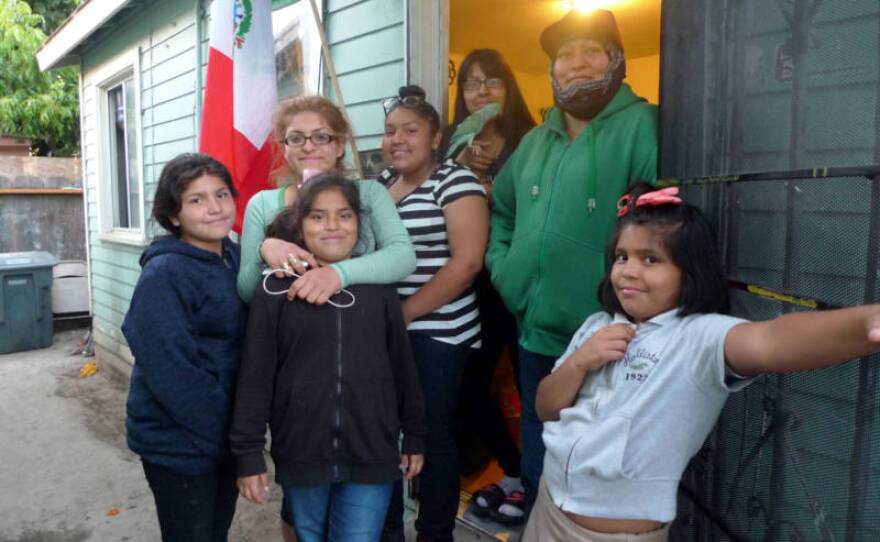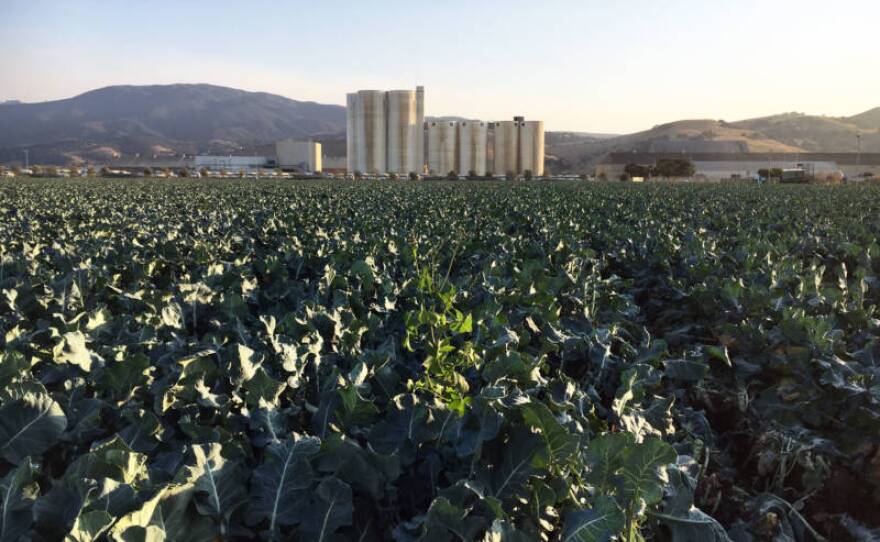If you’ve read your John Steinbeck and listened to your Merle Haggard, or if you grew up in a farmworker family, you know that farm laborers in California have struggled to find decent housing for decades.
Except in a few cases, growers have no legal obligation to house employees, and there’s not a lot of state and federal money earmarked for farmworker housing. In the Salinas Valley — the fifth- least-affordable place to live in the country — there’s just not enough decent housing for all the people needed to pick crops like lettuce and strawberries.
If you’re a farmworker in the Salinas Valley, odds are, you’re living in the neighborhood of East Salinas. When I visit 18-year-old Rocio Tafoya at her apartment here, one of the first things she shows me is the bathroom. It has water damage and mold, and a tiny shower she can barely turn around in.
“This is how we open the cold water.” She grabs a wrench, and yanks on what’s left of the knob. “We don’t have hot water right now, it’s just cold.”
This is the only bathroom shared by the 11 people who live in this barely two-bedroom house. Her mother, also named Rocio Tafoya, walks in the door after a day working in the fields transplanting broccoli, cauliflower and radicchio. She wears a blue hardhat for safety, a bandana to protect her from both sun and cold, and carries a transistor radio in another bandana attached to her belt loop.
In Spanish she says, “I have to have my music!” and laughs.
I ask how much she makes.
“I usually make $500 or $600 a week.”
But rent is $1,600 a month, for a house where she says she can hear “rats dancing.” Her teenage daughters work with her during the summer, but, I ask, how does she make that math work?
“Well, with the help of God,” she says.
Her oldest daughter, Rocio, tells me this is better than their last place.
“That house, no lie, we used to live 34 people in total,” she says.
Her family of nine shared one room. She says the landlady even made bunk beds in the laundry room, which she would rent out to older men, often drug addicts and drunkards. When her mom would leave for the fields at 3 or 4 in the morning, Rocio Tafoya says sometimes they’d come knocking on the door.
“Trying to make us open the door,” she says. “That’s something scary I don’t want to experience again.”
I meet the Tafoya family through community organizer Joel Hernandez, who gives me a tour of East Salinas, where he grew up. The housing density is claustrophobic.
“You’ll see just apartment complexes everywhere,” he says. “Every single piece of property is crowded with one, two, three layers of them.”
He points out mobile homes and converted sheds stuffed into available yard spaces.
“In some situations, garages are being rented out,” he says.
Where houses stand alone, the number of vehicles overflowing from the street, parked on lawns, indicate these aren’t single-family homes. Hernandez says typically renters won’t report substandard conditions for fear of becoming homeless.
Today’s Salinas Valley would be unrecognizable to those who lived here in the late 1800s, according to community historians Jim Ross Riley and Ken Dursa.
“The Salinas Valley was just grains, hay and grains, and cattle,” says Riley.
When “suddenly the industrial revolution shows up in 1898, big time, big time,” Dursa says.
International sugar production magnate Claus Spreckels convinced local farmers to grow sugar beets, and he built a state-of-the-art factory, the biggest in the world, just outside Salinas.
“That was his trademark,” says Dursa. “The biggest and the best. The most modern.”
Around his factory, Spreckels built a town he named after himself, with simple, four-room houses for some workers, grander homes around the park for supervisors.
“You had to work for Spreckels Sugar to live in the town,” says Riley, who still lives in the house his grandfather got to rent, dirt cheap.
Ken Dursa worked in the warehouse and electric shop and represented the union for years.
“The whistle went day and night like an air raid siren,” he says. “They even ran it at midnight,” for folks working graveyard shift.
Dursa rifles through memorabilia, showing me the time cards of one John Steinbeck. He tells me, during the big sugar processing campaigns, “If you were anybody you worked at the factory.”
John Steinbeck may have made agriculture in this valley famous, but Claus Spreckels made it possible.
“He introduced modern row crop agriculture to the entire Salinas Valley,” says Riley.
Dursa adds, “The main impact was irrigation. He built the ditches, built the pumps, laid out fields, brought in agronomists. No irrigation, no sugar beets.”
Those innovations had unintended consequences down the line. Crops like lettuce flourished (people referred to iceberg as “green gold”) and became more profitable than sugar beets. Local farmers stopped growing them, and transportation of beets from other parts of the state became too expensive. The factory stopped all operations in 1995.
“And it’s gone now,” says Ken Dursa, tearing up. “The factory’s what fed us. Fed us and supported us. A lot of good people worked there and it’s just gone.”
Two years later the site was purchased by agriculture giant Tanimura and Antle — which probably grew the lettuce in your last salad. This past spring, the company built new housing for workers where the factory once stood.
After eight hours packing artisan romaine lettuce, Lucia Jaquez and Maricela Williams show me the apartment they share with three other women. Two bedroom/bathroom suites open onto a common living room and kitchen. It’s like a suite at a really spacious dorm.
They invite me to stay for dinner — chicken mole and rice. Both women are based near Yuma, Arizona, and work for Tanimura and Antle there. But last year, Jaquez decided to come up to work for the company for the Salinas Valley’s longer, more profitable season.
All she could afford to rent was a single, windowless room on a tough East Salinas street. With no access to a kitchen, she had to eat out, and some days she could afford only one meal. She says she felt so uncomfortable and unsafe, she swore she’d never return.
At this new worker housing called Spreckels Crossing, she has private security and low rent and lots of amenities like laundry and a convenience store, even sports fields and ESL classes. That seems great, except to a number of residents of modern-day Spreckels.
The town is a quiet, peaceful enclave, only four blocks square with just over 700 residents. It has one park, one church, one general store without much on its shelves. The surprise announcement that Tanimura and Antle wanted to house up to 800 single workers in apartments on the edge of town made some residents worry their quality of life was in jeopardy.
In public meetings, they raised concerns about the well-being of the farmworkers, especially citing the isolation they might feel so far from shopping and activities in Salinas. They also worried about infrastructure like water and sewage and traffic, about potential drops in housing prices. Some feared the project could draw prostitution, drug use, cockfights. Lifelong resident Jim Ross Riley collected and presented many of his neighbors’ concerns.
“Some news media said that we were racist,” Riley says. “I don’t care what church, or race or nationality they are, they are single males in their 20s and 30s and they don’t stay home and knit.”
It got pretty heated. But nothing compared to what happened in the town of Nipomo, two hours south. Seven farmworker houses under construction were burned to the ground. Everyone I talked to in Spreckels says that would never happen here.
“I am not against farmworkers coming to the area,” says Riley. “They are needed. I’m very concerned about their living conditions.”
But some Spreckels residents say Tanimura and Antle isn’t paying enough attention to their concerns.
“That’s what upsets people is they get to do whatever they want,” Riley says.
And Tanimura and Antle wanted worker housing. Let’s be really clear. This was a business decision.
President and CEO Rick Antle says the company never had a problem attracting workers in the Salinas Valley, “but in April of 2015, we actually depleted all of our lists of people looking for jobs, and we ended up about 200, 300 workers short,” he explains.
That’s about 15 percent of their workforce. He says crops rotted in the field. “What it told us was that the situation was only going to get worse.”
Now, he’d heard the stories of 20 workers sharing two-bedroom homes, and people living in garages — but the company hadn’t made the connection between the housing shortage and the labor shortage.
So Tanimura and Antle started planning to hire temporary guest workers on what’s called H2A visas. California is bringing them in at a faster rate than the rest of the country, and the Salinas Valley is driving that surge. Employers must provide housing for temporary workers. Some growers and labor contractors rented out whole hotels, but Antle says the company decided to build their own, at a cost of $17 million.
To the company’s surprise, their domestic workers based in the San Joaquin Valley and Arizona — people like Lucia Jaquez and Maricela Williams — said, “If you build affordable housing in Spreckels, we’ll come.” Nearly 300 employees did.
“With that we’ve been about to fully staff our crews,” Antle says. “We’ve had no losses in crops this year.”
For much of the last century, workers in the Salinas Valley and across California often lived in worker housing: labor camps, close to the fields on growers’ land. Historians and housing advocates told me that, in the 1970s, after victories in the farmworker movement, the state enacted laws regulating employee housing. Many growers started tearing down substandard camps. Now, many workers have to find their own housing, and nonprofits are trying to fill in the gaps.
Housing advocates are holding up Tanimura and Antle’s project as a model, but most growers can’t afford such an investment. Plus, this housing’s not a fix for year-round Salinas Valley workers. And even though it’s estimated that 80 percent of California farmworkers have home bases and families, Tanimura and Antle’s housing is only for employees: no kids allowed. I ask Antle: Isn’t the real need for farmworker family housing?
“Yes,” he says. “And we’ll be addressing that.”
While he wouldn’t give me more details, he later pointed out two huge storage sheds right next to the new housing he says will be Phase Two. Meanwhile, one nearby grower is getting permits to build similar apartments, and local governments are investing in a farmworker housing study.
This doesn’t change life for the Tafoya family in that cramped East Salinas house. That study won’t address their immediate needs, and, as a family, they wouldn’t qualify for worker-only housing. I ask: Who’s responsible for making sure there’s affordable housing for farmworkers? Mom says local politicians are. She and her daughter, Rocio Tafoya, both say growers should chip in. Then the younger Tafoya points out the bigger picture.
“California is the one that produces the lettuce for everyone in the United States and probably it’s something the state should do, too,” Tafoya says, “because we’re the workers. I don’t want to say we feed you, but …”
She says they deserve better.
Lisa Morehouse reported this story as part of the UC Berkeley-11th Hour Food and Farming Journalism Fellowship. California Foodways is supported in part by California Humanities. She received research help from Meradith Hoddinott.





